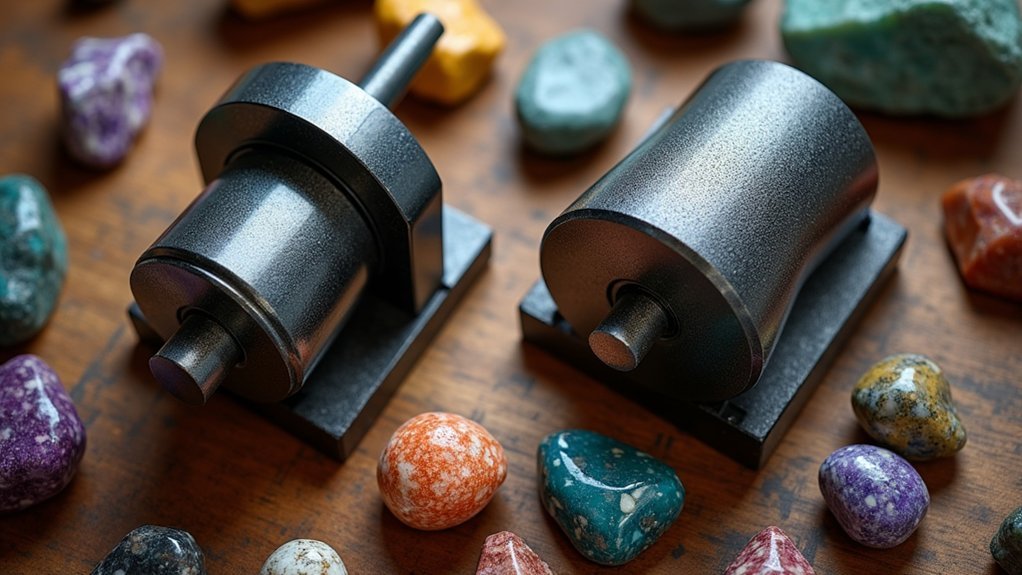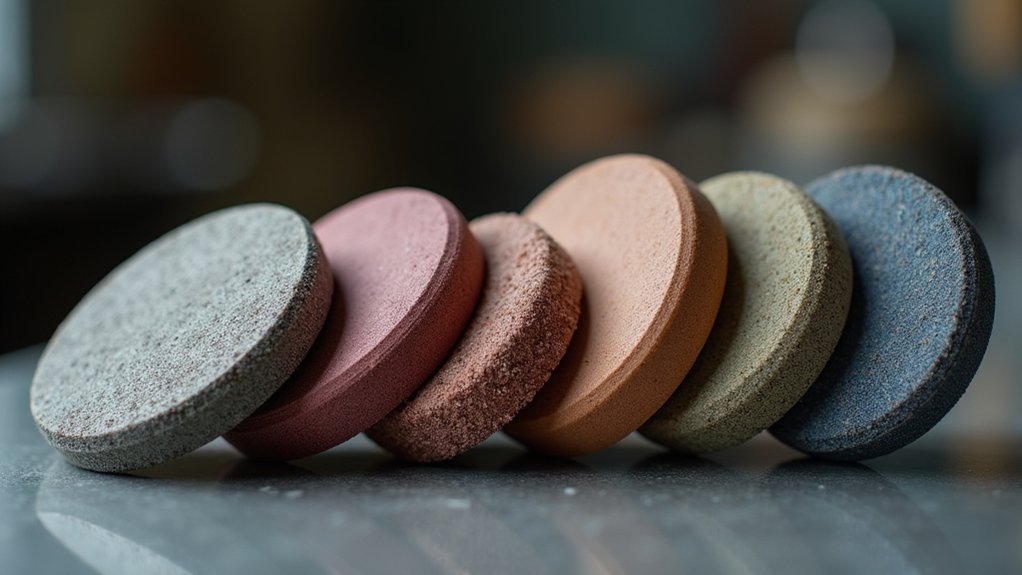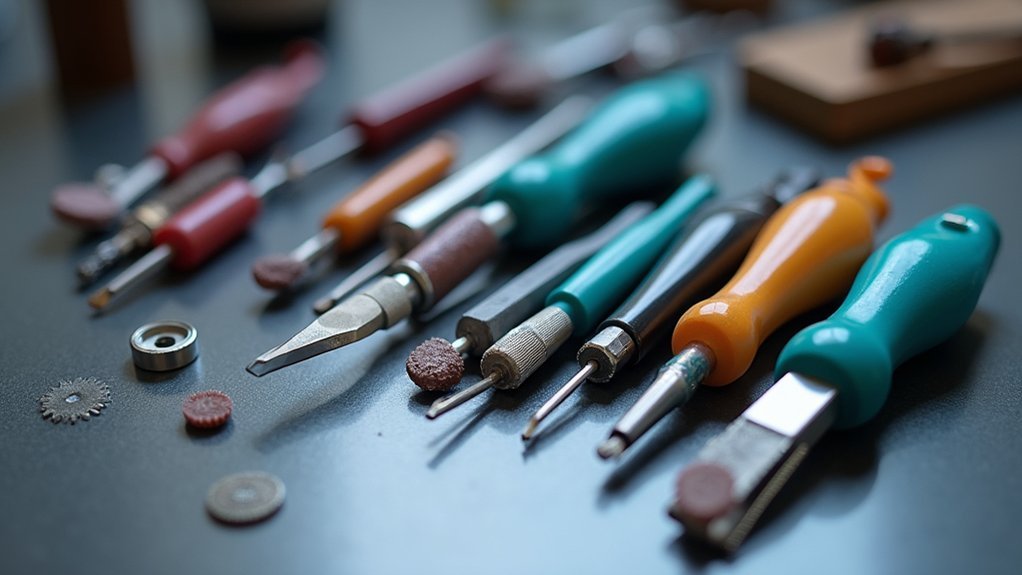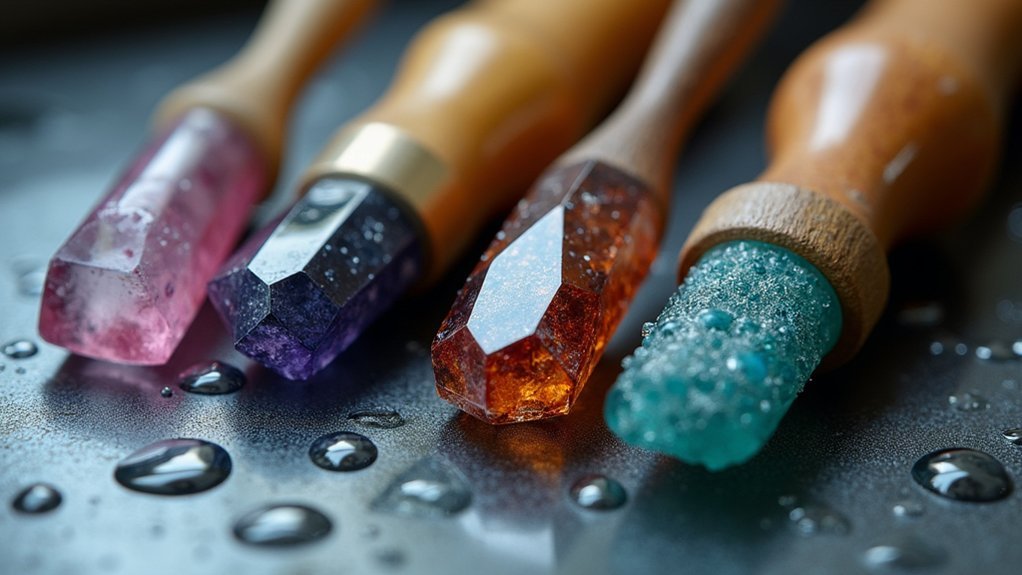You’ll find five essential gemstone polishing tools that’ll elevate your lapidary work. Rotary tumblers handle larger batches over weeks, while vibratory models polish stones in days with gentle action. Diamond saws provide unmatched cutting precision with circular diamond-coated blades. Grinding wheels progress from coarse 60-100 grits to fine 3000 grits for mirror finishes. Flat lap machines offer variable speed control for different processes, and compact trim saws excel at detailed work. Each tool’s unique capabilities will transform your gemstone crafting experience.
Rock Tumblers: Rotary Vs Vibratory Models

When choosing between rotary and vibratory rock tumblers, you’ll find two distinct approaches to achieving polished gemstones.
Rotary tumblers provide consistent grinding action through continuous barrel rotation, making them perfect for larger batches and heavier loads. They’ll take several weeks to deliver that coveted high shine, requiring multiple abrasive grits changes throughout the polishing process.
Vibratory tumblers offer a faster alternative with their efficient vibrating motion, completing polishing stones in just days. Their compact design suits hobbyists with limited workspace, while their gentle polishing action protects delicate specimens.
Though both rock tumblers use abrasive grits and water, vibratory models typically produce smoother finishes more quickly, making them ideal for experienced collectors seeking efficient results.
Diamond Saws: Precision Cutting Performance
For precision cutting that transforms rough gemstones into workable pieces, diamond saws deliver unmatched accuracy through their circular diamond-coated blades.
You’ll find these tools essential for shaping and trimming stones effectively in your lapidary workshop.
Diamond saws come in various sizes and speeds, so you can adapt to different stone types and cutting needs. Whether you’re a beginner or experienced lapidary enthusiast, you’ll appreciate their versatility.
Diamond saws adapt to any stone type with variable sizes and speeds, making them perfect for both beginners and experienced lapidary enthusiasts.
The blade quality greatly affects lifespan—sintered diamond blades typically outlast electroplated options.
Proper maintenance enhances cutting efficiency while preventing damage to your machine and gemstones. You can’t compromise on quality for serious lapidary work.
Investing in high-quality diamond saws guarantees accuracy and directly impacts your finished gemstone quality, making them indispensable for professional results.
Grinding and Polishing Wheels: Grit Selection Guide

After cutting your gemstones to size, grinding and polishing wheels become your primary tools for transforming rough surfaces into brilliant, mirror-like finishes.
You’ll need to select appropriate grit sizes for each stage of your work. Start with coarse grits (60-100) for initial shaping and aggressive material removal, then progress through finer grits up to 3000 for that professional-grade polish.
Diamond wheels offer superior polishing capabilities, with sintered options providing exceptional durability for harder materials. You’ll find they outlast electroplated alternatives considerably.
Proper maintenance extends your wheels’ effectiveness—clean them regularly to prevent contamination. Following a systematic grit progression from coarse to fine guarantees you’ll achieve high-quality, mirror-like results.
Flat Lap Machines: Variable Speed Control
Flat lap machines take your gemstone finishing capabilities to the next level with their variable speed control systems.
You’ll adjust rotation speeds precisely for different stones and processes, protecting delicate materials while achieving superior results. These machines typically offer slow speeds for coarse grinding and faster speeds for polishing gemstones, giving lapidary artists complete versatility throughout their workflow.
Variable speed control enhances your precision when creating precision finishes, preventing damage that fixed-speed machines might cause.
Variable speed control gives you the precision needed for flawless finishes while protecting your gemstones from costly damage.
You’ll also conserve abrasive materials by selecting ideal speeds for each stage of your sanding process. The Hi-Tech Diamond 6 All-U-Need stands out among popular models, combining user-friendly design with efficient performance.
This speed flexibility transforms how you approach different lapidary techniques, making complex projects more manageable and successful.
Trim Saws: Compact Design Efficiency

Trim saws deliver compact design efficiency that transforms your workspace without sacrificing cutting performance. These tools feature diamond-coated blades ranging from 4 to 8 inches, perfect for shaping rough stones into manageable pieces for your lapidary projects.
| Feature | Specification | Benefit |
|---|---|---|
| Blade Size | 4-8 inches | Precision cutting |
| Speed Control | Variable speeds | Versatile gemstone cutting |
| Workshop Space | Small footprint | Ideal for home workshops |
You’ll appreciate how trim saws accommodate different cutting needs through variable speeds, enhancing their efficiency for detailed work. Their compact design makes them particularly valuable for home workshops, where space is often limited. The diamond-coated blades provide the precision and durability you need for intricate designs while maintaining professional results in your gemstone cutting endeavors.
Frequently Asked Questions
What Is the Best Polish for Gemstones?
You’ll find oxide polish works best for most natural gemstones, enhancing their shine and clarity effectively. For softer stones like opals, you should use cerium oxide polish to prevent damage while achieving excellent results.
What Do Jewelers Use to Polish Stones?
You’ll find jewelers use rotary and vibratory tumblers, flat lap machines, polishing wheels in various grits, and diamond polishing paste. They select tools based on gemstone type and desired finish quality.
What Is the Difference Between Lapidary and Gem Cutting?
You’ll find lapidary covers all gemstone work including cutting, grinding, and polishing, while gem cutting specifically focuses on creating precise facets. Lapidary’s the broader craft; gem cutting’s the specialized skill within it.
What Tools Do I Need for Lapidary?
You’ll need rock tumblers for polishing, diamond saws for cutting, grinding wheels for shaping, and flat lap machines for finishing. Don’t forget safety gear like goggles, gloves, and dust masks for protection.
In Summary
You’ve now explored five essential gemstone polishing tools that’ll transform your rough stones into brilliant gems. Whether you’re choosing between rotary and vibratory tumblers, selecting the right diamond saw for precision cuts, or deciding on grinding wheel grits, each tool serves a specific purpose. Consider your project requirements, workspace limitations, and budget when selecting equipment. With proper technique and the right tools, you’ll achieve professional-quality results in your gemstone polishing endeavors.





Leave a Reply